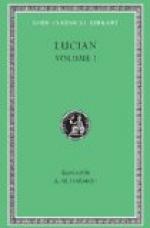The illustration of the interior of Independence Hall on page 17, was furnished for use in this work by the National Company of St. Louis, publishers of “Our Own Country,” a large work descriptive of a tour throughout the most picturesque sections of the United States. The letter-press in “Our Own Country” was written by the author of this work, and it is one of the finest tributes to the picturesqueness of America that has ever been published. Other illustrations in this work were also kindly supplied by the same publishing house.
CHAPTER II.
THE WITCHES OF SALEM.
A Relic of Religious Bigotry—Parson Lawson’s Tirade Against Witchcraft—Extraordinary Court Records of Old Puritan Days—Alleged Supernatural Conjuring—A Man and his Wife both put to Death—Crushed for Refusing to Plead—A Romance of the Old Days of Witch Persecution.
Among the curiosities of New England shown to tourists and visitors, is the original site of some of the extraordinary trials and executions for witchcraft in the town of Salem, now known as Danvers, Mass. Looking back upon the events of two hundred years ago, the prosecution of the alleged witches appears to us to have been persecution of the most infamous type. The only justification for the stern Puritans is the fact that they inherited their ideas of witchcraft and its evils from their forefathers, and from the country whence most of them came.
One of the earliest precepts of religious bigotry was, “Thou shalt not allow a witch to live,” and from time immemorial witchcraft appears to have been a capital offense. It is on record that thousands of people have, from time to time, been legally murdered for alleged intercourse and leaguing with the Evil One. The superstition seems to have gained force rather than lost it by the spread of early Christianity. As a rule, the victims of the craze were women, and the percentage of aged and infirm women was always very large. One of the greatest jurists of England, during the Seventeenth Century, condemned two young girls to the gallows for no other offense than the alleged crime of having exerted a baneful influence over certain victims, and having, what would be called in certain districts, “hoodooed” them.
In Scotland the craze was carried to still further lengths. To be accused of witchcraft was to be condemned as a matter of course, and the terrible death of burning at the stake was the invariable sentence. Most of the victims made imaginary confessions, preferring to die at once than to be tortured indefinitely. In the year 1716, a wealthy lady and her nine-year-old daughter were hanged for witchcraft, and even thirty or forty years later the records of Great Britain are sullied by another similar case of persecution.




